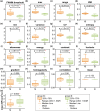Diffuse correlation tomography: a technique to characterize tissue blood flow abnormalities in benign and malignant breast lesions
- PMID: 39553863
- PMCID: PMC11563337
- DOI: 10.1364/BOE.535330
Diffuse correlation tomography: a technique to characterize tissue blood flow abnormalities in benign and malignant breast lesions
Abstract
Accurate assessment and quantification of neoangiogenesis associated with breast cancer could be potentially used to improve the sensitivity and specificity of non-invasive diagnosis, as well as predict outcomes and monitor treatment effects. In this study, we adapted an emerging technology, namely diffuse correlation tomography (DCT), to image microvascular blood flow in breast tissues and evaluate the potential for discriminating between benign and malignant lesions. A custom-made DCT system was designed for breast blood flow imaging, with both the source-detector array and reconstruction algorithm optimized to ensure precise imaging of breast blood flow. The global features and local features of three-dimensional blood flow images were extracted from the relative blood flow index (rBFI), which was obtained from most of the breasts targeted to the lesion. A total of 37 women with 19 benign and 18 malignant lesions were included in the study. Significant differences between malignant and benign groups were found in 12 image features. Moreover, when selecting the lesion mean relative blood flow index (MrBFI) as a single indicator, the malignant and benign tumors were discriminated with an accuracy of 89.2%. The blood flow features were found to successfully identify malignant and benign tumors, suggesting that DCT, as an alternate functional imaging modality, has the potential to be translated into clinical practice for diagnosis and assessment of breast cancers. There is potential to reduce the need for biopsy of benign lesions by improving the specificity of diagnostic imaging, as well as monitoring response to breast cancer treatment.
© 2024 Optica Publishing Group.
Conflict of interest statement
The authors declare that there are no conflicts of interest related to this article.
Figures





Similar articles
-
Improving suspicious breast lesion characterization using semi-automatic lesion fractional volume washout kinetic analysis.Med Phys. 2011 Nov;38(11):5998-6009. doi: 10.1118/1.3651635. Med Phys. 2011. PMID: 22047364
-
Assessment of Functional Differences in Malignant and Benign Breast Lesions and Improvement of Diagnostic Accuracy by Using US-guided Diffuse Optical Tomography in Conjunction with Conventional US.Radiology. 2016 Aug;280(2):387-97. doi: 10.1148/radiol.2016151097. Epub 2016 Mar 2. Radiology. 2016. PMID: 26937708 Free PMC article.
-
More advantages in detecting bone and soft tissue metastases from prostate cancer using 18F-PSMA PET/CT.Hell J Nucl Med. 2019 Jan-Apr;22(1):6-9. doi: 10.1967/s002449910952. Epub 2019 Mar 7. Hell J Nucl Med. 2019. PMID: 30843003
-
Radiomics to Differentiate Malignant and Benign Breast Lesions: A Systematic Review and Diagnostic Test Accuracy Meta-Analysis.Cureus. 2023 Nov 18;15(11):e49015. doi: 10.7759/cureus.49015. eCollection 2023 Nov. Cureus. 2023. PMID: 38024014 Free PMC article. Review.
-
Role of In Vivo Reflectance Confocal Microscopy in the Analysis of Melanocytic Lesions.Acta Dermatovenerol Croat. 2018 Apr;26(1):64-67. Acta Dermatovenerol Croat. 2018. PMID: 29782304 Review.
Cited by
-
Advances in Musculoskeletal Ultrasound for Assistive Diagnosis in Pain Clinics.Pain Ther. 2025 Jun;14(3):791-801. doi: 10.1007/s40122-025-00721-x. Epub 2025 Mar 15. Pain Ther. 2025. PMID: 40088259 Free PMC article. Review.
-
AI-assisted diffuse correlation tomography for identifying breast cancer.J Biomed Opt. 2025 May;30(5):055001. doi: 10.1117/1.JBO.30.5.055001. Epub 2025 May 16. J Biomed Opt. 2025. PMID: 40385570 Free PMC article.
References
LinkOut - more resources
Full Text Sources
